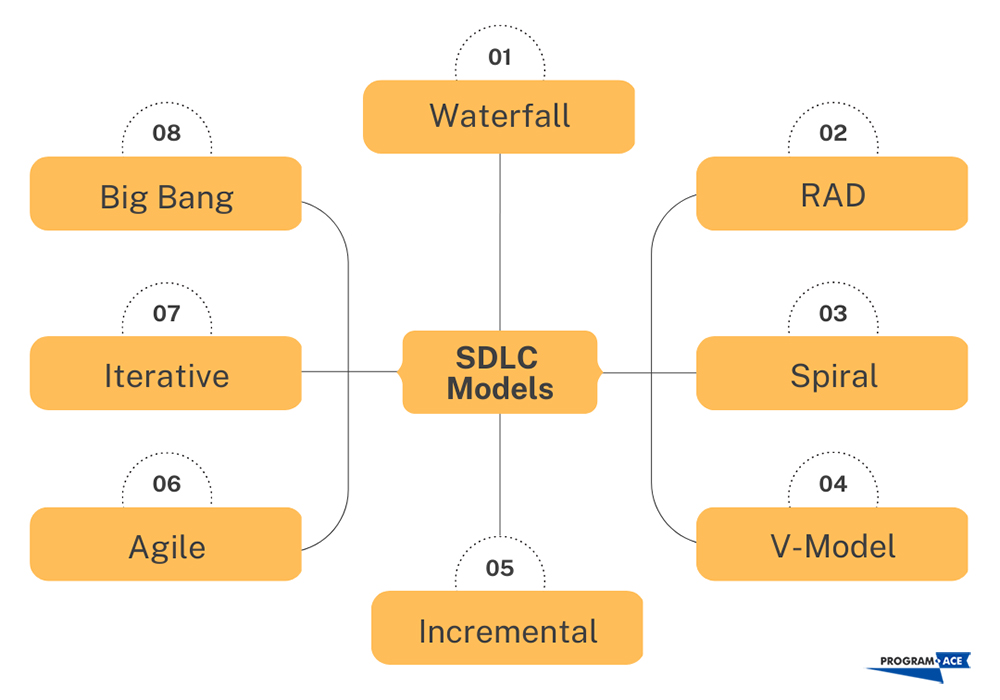Standing for the software development life cycle, the SDLC is a systematic approach to app creation, a so-called project management model that allows teams to build digital solutions more optimally. Not only does it help optimize resources for software companies, but also it facilitates the development process, makes it cost-effective, and allows for flexibility.
Although every custom software development company has its own SDLC, this project management approach remains in a similar form, including such phases as requirements analysis, feasibility study, planning, coding, deployment, and maintenance. Using this framework, software developers can always turn back in time and fix what’s broken or receive approval from the client to move on.
In this article, we’ll talk about the phases and models of the software development life cycle as well as provide insights into how you can implement this approach in your own development phase. Read on to reveal the secrets!
Phases of the Software Development Life Cycle

The primary technique and approach to software development imply splitting every task or problem into smaller bits, trying to analyze each of them separately. The same goes for the software development life cycle model — it divides the entire development process into more feasible chunks of work that need to be done. So what are these development phases?
1. Requirements analysis
As the initial stage in software development, requirements analysis presupposes collecting all the available information about an application or solution that has to be finished throughout the current project. Its specifications, target audiences, features, and other crucial aspects are gathered as well as analyzed in order to build a clear plan on how to approach the app.
Planning before working with code helps software development teams, which operate according to the SDLC, visualize each aspect of the future application in greater detail, thereby minimizing the risks while maximizing the end quality.
2. Feasibility study
This software development phase aims to ensure that the requirements analysis resonates with the corporate culture and business goals and will not empty the resources to the fullest. In other words, the development team evaluates every detail touching upon the future application to establish its feasibility level and make changes if needed.
Usually, this development cycle ends with a self-explanatory software requirements specification document (SRS). It must be approved by the Tech Lead and the client (for outsourcing companies).
3. Designing & planning
During this software development cycle, a team creates the design of an upcoming application, including its user interface, architecture, primary features, cybersecurity aspects, and the rest. Planning serves as the primary preliminary measure to avoid possible miscommunication, repetitive revisions, or the emergence of critical bugs.
As a rule, the output of this development phase is a software design document (SDD) or the Detailed Design Specification (DDS) that provides comprehensive information regarding how and with what means to code the application.
4. Software development
As the software development life cycle and phase, coding involves transforming the previously built design into the system using a specific set of programming languages, frameworks, APIs, etc. A team of developers and designers work in conjunction to ensure the best performance, quality, as well as understanding of the target audience’s preferences.
In most cases, this development phase ends with a fully functional and straightforwardly testable prototype, enabling the team to move on to the next cycle.
5. In-depth software testing
It’s the stage when quality assurance specialists get to work and refer to multiple software test types, such as performance, functional, integration, acceptance, smoke, stress testing, etc., to ensure that the final product version will be devoid of critical issues. The result of this software development phase usually defines the future of any application.
Once QA experts are done testing a piece of software, the output of their work is a totally polished and functional app, which is ready for its primary challenge — deployment.
6. Deployment
Deployment means delivering the tested software to the end user. In other words, the development team releases the application for beta testing. Even though it’s already been scrutinized from all corners, it’s time for the target audience to say their word. The team can move on to release and maintenance only after collecting their feedback.
As soon as all the information is gathered and processed, the team fixes any issues spotted so that the app's final version can be freely published.
7. Maintenance
Even long after release, any software product needs some updates or new features because there are no better testers than time and real-world usage. Production support engineers, QA specialists, and programmers are responsible for maintaining a piece of software even after it’s been shipped to users.
This phase ending the SDLC, the life of software products continues as long as their functionality satisfies the target audience until the features are deemed unnecessary.
The SDLC Models You Should Learn About

While the software development life cycle is a somewhat abstract project management model, which is always kept in mind and never revisited, there are numerous more specific as well as practice-oriented approaches to building applications. Nowadays, teams worldwide take advantage of such SDLC models as the Waterfall, RAD, Spiral, V-Model, Incremental, Agile, Iterative, and Bigbang. For more details — look below.
Waterfall model
As a continuous software development model with its phases, it is perceived as a steadily downward process that resembles a waterfall. Requirements analysis, design, implementation, quality assurance, and maintenance are passed one by one, straightforwardly. Such a linear ordering of workflows has both benefits and downsides to it.
Although the Waterfall model is still one of the most famous approaches to working with each software development life cycle step by step, more and more companies refrain from using its principles as they lack flexibility when it comes to fixing issues or getting approval.
RAD model
Rapid Application Development, or simply RAD, is a software development model that heavily depends on quick decisions. As the name itself suggests, the RAD model prioritizes rapid software development within lesser time. This result is usually achieved by following these development phases:
- business modeling;
- data modeling;
- application generation;
- testing and turnover.
Most often, teams refer to this SDLC model to develop software within 2-3 months when they have precise project requirements and when the technical risks are extremely low.
V-Model
The V-Model is another software development life cycle conceptual framework, also known as the Verification and Validation model. Just like many other workflows, it stems from the Waterfall model, having borrowed from it the impossibility of starting a new phase without finishing the previous one.
As usual, your software development team has to know all the project requirements before they start to apply this model, inasmuch as it’s difficult to go back in time and make changes if you opt for the V-Model.
Spiral model
Unlike the previous SDLC models, the Spiral is one of the most flexible methodologies as it heavily relies on the Iterative framework. Teams that stick to the Spiral model go through 4 phases over and over as they are shaped in spirals, thereby ensuring multiple micro-stages of refining the software. With the help of this framework, you can build customizable apps.
The only drawback is that your development team can make changes infinitely, with the same rounds going on and on until the client is satisfied with the result.
Incremental model
Even though the Incremental model is usually distinguished from others, it’s actually part of the Waterfall conceptual framework, indicating a series of its cycles. In the context of this SDLC model, all the project requirements are divided into groups, and the team adds functionality with every new phase, which can start even before the previous is complete.
The Incremental software development model allows for cycle overlapping, and each phase serves as the maintenance phase for the previous one, thereby facilitating more flexibility.
Agile model
The Agile methodology is by far one of the most widespread and famous software development life cycle models. Without a doubt, it promotes continuous and iterative development processes. Therefore, the whole project is split into small incremental builds, enabling developers to work iteratively, with each sprint lasting from 1 to 3 weeks.
Unlike the Waterfall model, the Agile methodology is more flexible as well as allows for more straightforward software customization on the go because phases are simultaneous.
Iterative model
The Iterative framework promotes an easier start and goes more difficult with each iteration. Consequently, the team relies on iterations (an exact set of SDLC phases clearly outlined in time), and with each new cycle, the software gets better until it’s finally released by the end of the last iteration.
Notably, the Iterative model is most helpful when the requirements are coherently defined, when your target app is medium- or large-scale, as well as the odds are that a team will need to make changes to the project on the go.
Big Bang model
The Big Bang model isn’t like the rest of the software development life cycle models. It promotes following no specific phases or processes, let alone that only a small percentage of work is dedicated to planning, which doesn’t fit a lot of real-world projects out there. Most resources are employed to program an application straightforwardly, often without even clearly comprehending the project requirements.
In contrast to other SDLC models, the Big Bang framework perfectly suits small teams and pet projects, so software development companies incredibly rarely use it.
Looking for professional software developers?
Benefits of the SDLC: Why Do Teams Stick to Models?
Each SDLC model has some advantages and disadvantages to it, so it’s essential to know when as well as in what case to apply this or that conceptual framework. If narrowed down and simplified, the use of any of the aforementioned software development life cycles (except the Big Bang) provides the following benefits:
Optimized scope management. With continually changing project scopes, development teams start lacking motivation and clear vision, which obviously, results in poor performance. If you apply, say, the Agile model, you’ll have a time-proven workflow before your eyes and written in the documentation. So it’s simpler and cost-efficient to rely on the already conceptualized framework without having to reinvent the wheel over and over again from project to project.
Fewer risks. Using any SDLC model that promotes an iterative approach to software development adds flexibility to your project execution. In other words, you’ll be able to lose fewer resources whenever a client wants to add a new feature or make changes to the project under development in case you follow a strict pipeline.
Challenges are spotted sooner. Since almost every modern software development life cycle model stands on the pillars of planning and designing before implementing, you’ll be able to incorporate a feature only after analyzing its feasibility and value.
In any event, companies adhere to a specific SDLC model because software development continually changes, and clients always change their minds, so it’s good to have a time-proven framework at your fingertips. Your team can always go back in time and use the combination of “ctrl/cmd” plus “z” keys in real life and with actual people. Sounds helpful, right?

Use Program-Ace’s Potential to Develop Quality Software
As a leading provider of software engineering services, our team leverages various SDLC methodologies to ensure the optimal approach for each project. At Program-Ace, our focus is on delivering a client-centric experience, tailoring our frameworks and technology stacks to meet the unique needs of each project. Our experienced software engineering services allow for fast, effective changes without compromising quality or putting your project at risk.
Don't wait, contact us today for more information and take the first step towards delivering your software development project with confidence.
FAQ
1. Where is the SDLC used?
The software development life cycle is a conceptual framework that guides teams throughout each phase of app creation. Nowadays, almost every professional software development company sticks to a particular SDLC model, whether it’s Incremental, Iterative, Agile, or any other. The purpose is to frame the workflow in order to minimize risks, repetitive tasks, and costs.
In today’s competitive business world, any software you see on the global market is built using this or that SDLC model, inasmuch as it’s impossible for mid- and large-scale companies to develop applications without a rigid conceptual framework. It’s almost inevitable that you adhere to a particular set of principles in your approach to software development, so it’s more cost-effective to take advantage of what’s already been proved by time and years of other players’ practice.
Imagine you want to create VR training software. How do you approach project execution? What phase is the best to start from? Why even ponder over such repetitive things if you can use a conceptual framework, a technical guideline that already contains the answers to these and many other essential questions that companies worldwide ask from project to project? After all, software development companies tend to go down the path of automation and unifying repetitive tasks.
With, say, the Agile methodology onboard, your development team will be able to create that VR training app as soon as possible, already keeping in mind the initial and final phases. That’s how you ensure a consistent and cost-effective software development life cycle that helps you stay focused and prioritize processes that define your product in the end.
2. What SDLC model is the best?
It’s no secret that each SDLC model fits a specific project and helps resolve certain issues while putting others in peril, so there’s no perfect framework in this aspect. However, you can learn what software development life cycle suits your project best in each unique case. Let’s review some of the most widely used SDLC models considering use cases.
Rapid Application Development (RAD). In what case will this model be of the highest value to your project? Primarily, it fits software development teams that have a unique idea, which is confidential and has to be implemented within the shortest time frame. You should make use of the RAD model if you’ve got no time for detailed planning.
Incremental Model. Whenever you need to prioritize scalability and flexibility, you had better opt for this conceptual framework, inasmuch as it allows your team to implement project requirements in great detail while considering a broader purpose. It’s worth a shot if you have time for extensive prototyping and breaking the project into smaller increments.
Spiral Model. It best fits your project execution pipeline if you have an unclear vision of the requirements and foresee frequent changes made to an app. As a prototype-based SDLC model, it enables you to rely on iterations and make a highly customizable product.
Waterfall Model. One of the most traditional frameworks, the Waterfall model, brings the most benefits when you have a good grasp of clear goals, requirements, and resources. Also, you may want to use this model if your project’s starting and ending dates are already established, let alone if a client desires to make changes during every software development phase.
Agile-Scrum Methodology. Quite often, Agile and Scrum are considered synonymous, though they don’t mean the same thing. While Agile is a project model and philosophy based on the iterative approach to software development, Scrum is the most popular practical methodology in the context of the Agile SDLC framework. It’s most relevant for large, architecture-heavy projects with continually changing requirements, deadlines, and features to be implemented.
For more in-depth and custom-tailored suggestions, feel free to contact specialists at Program-Ace, who will quickly guide you through each software development phase. Besides, you can even discuss your upcoming project’s requirements with us.
3. What are the benefits of the SDLC for business?
Since you merely cannot imagine a modern software development project without using a particular SDLC model, there must be a whole bunch of persuasive benefits for businesses. Apart from many other advantages, below you can read about the most evident ones:
Better end quality. The software you work on heavily depends on the approach you adhere to during every development phase. If you utilize an SDLC model, you inevitably increase the final quality of a product simply because you follow a time-proven guideline.
More rapid development. Imagine a project without any management when the team simply doesn’t know where to start and what’s the final stage of what they do. And now, picture a team of experts who know the ropes, strictly following a certain software development philosophy. They spend less time on redundant activities and simply focus on the process itself.
Cost-effectiveness. There’s no denying that you spend fewer resources if you know what to do with a team, project requirements, business goals, deadlines, and other variables that are crucial to take into account before you start developing the software itself.
No matter what SDLC model you pick for your software development team and project management, you’ll certainly feel the difference even in daily tasks. Whether you opt for the Agile or Waterfall model, it’s always better to have a framework at hand instead of plunging into software development blindfolded.













